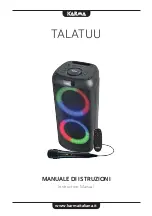
SiUS372201EB
Check
Part 6 Service Diagnosis
458
4.7 Vacuuming and Dehydration Procedure
CHECK 8
Conduct vacuuming and dehydration in the piping system following the procedure for Normal
vacuuming and dehydration described below.
Furthermore, if moisture may get mixed in the piping system, follow the procedure for Special
vacuuming and dehydration described below.
Normal vacuuming and dehydration
1. Vacuuming and dehydration
Use a vacuum pump that enables vacuuming up to 500 microns.
Connect manifold gauges to the service ports of liquid pipe and gas pipe and run the
vacuum pump for a period of 2 or more hours to conduct evacuation to 500 microns.
If the degree of vacuum does not reach 500 microns or less even though evacuation is
conducted for a period of 2 hours, moisture will have entered the system or refrigerant
leakage will have been caused. In this case, conduct evacuation for a period of another 1
hour.
If the degree of vacuum does not reach 500 microns or less even though evacuation is
conducted for a period of 3 hours, conduct the leak tests.
2. Leaving in vacuum state
Leave the compressor at the degree of vacuum of 500 microns or less for a period of 1 hour
or more, and then check to be sure that the vacuum gauge reading does not rise. (If the
reading rises, moisture may have remained in the system or refrigerant leakage may have
been caused.)
3. Additional refrigerant charge
Purge air from the manifold gauge connection hoses, and then charge a necessary amount
of refrigerant.
Special vacuuming and dehydration
Use this procedure if moisture may get into the piping, such as construction during the rainy season
(dew condensation may occur, or rainwater may enter the piping during construction work).
1. Vacuuming and dehydration
Follow the same procedure as that for normal vacuuming and dehydration described above.
2. Vacuum break
Pressurize with nitrogen gas up to 375,000 microns.
3. Vacuuming and dehydration
Conduct vacuuming and dehydration for a period of 1 hour or more. If the degree of vacuum
does not reach 500 microns or less even though evacuation is conducted for a period of 2
hours or more, repeat vacuum break - vacuuming and dehydration.
4. Leaving in vacuum state
Leave the compressor at the degree of vacuum of 500 microns or less for a period of 1 hour
or more, and then check to be sure that the vacuum gauge reading does not rise.
5. Additional refrigerant charge
Purge air from the manifold gauge connection hoses, and then charge a necessary amount
of refrigerant.
Summary of Contents for VRV EMERION REYQ-AATJA
Page 1: ...Service Manual Heat Recovery 60 Hz REYQ AATJA B 208 230 V REYQ AAYDA B 460 V SiUS372201EB...
Page 492: ...Wiring Diagrams SiUS372201EB 485 Part 7 Appendix BS6 8Q54TVJ 2D089122B...
Page 493: ...SiUS372201EB Wiring Diagrams Part 7 Appendix 486 BS10 12Q54TVJ 2D089121B...
Page 499: ...SiUS372201EB Wiring Diagrams Part 7 Appendix 492 FXFQ07 09 12 15 18 24 30 36 48TVJU 3D086460B...
Page 501: ...SiUS372201EB Wiring Diagrams Part 7 Appendix 494 FXZQ05 07 09 12 15 18TAVJU 3D110443A...
Page 505: ...SiUS372201EB Wiring Diagrams Part 7 Appendix 498 FXEQ07 09 12 15 18 24PVJU 3D098557A...
Page 506: ...Wiring Diagrams SiUS372201EB 499 Part 7 Appendix FXDQ07 09 12 18 24MVJU C 3D050501C...
Page 513: ...SiUS372201EB Wiring Diagrams Part 7 Appendix 506 FXHQ12 24 36MVJU 3D048116C...
Page 514: ...Wiring Diagrams SiUS372201EB 507 Part 7 Appendix FXAQ07 09 12 18 24PVJU 3D075354F...
Page 521: ...SiUS372201EB Wiring Diagrams Part 7 Appendix 514 VAM1200GVJU 3D073270D...
















































